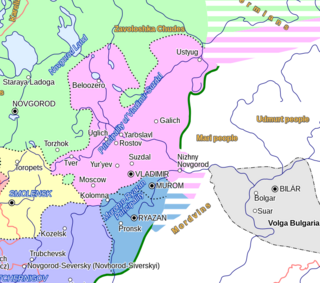
Vladimir-Suzdal, formally known as the Principality of Vladimir-Suzdal or Grand Principality of Vladimir (1157–1331), also as Suzdalia or Vladimir-Suzdalian Rus', was one of the major principalities emerging from Kievan Rus' in the late 12th century, centered in Vladimir-on-Klyazma. With time the principality grew into a grand principality divided into several smaller principalities. After being conquered by the Mongol Empire, the principality became a self-governed state headed by its own nobility. A governorship of the principality, however, was prescribed by a jarlig issued from the Golden Horde to a Rurikid sovereign.

Yuri I Vladimirovich, commonly known as Yuri Dolgorukiy or the Long Arm, was a Monomakhovichi prince of Rostov and Suzdal, acquiring the name Suzdalia during his reign. Noted for successfully curbing the privileges of the landowning boyar class in Rostov-Suzdal and his ambitious building programme, Yuri transformed this principality into the independent power that would evolve into early modern Muscovy. Yuri Dolgorukiy was the progenitor of the Yurievichi, a branch of the Monomakhovichi.

Yuri II, also known as George II of Vladimir or as Georgy II Vsevolodovich, was the fourth Grand Prince of Vladimir who presided over the Principality of Vladimir-Suzdal at the time of the Mongol invasion of Kievan Rus'.
Yaroslav II Vsevolodovich, also transliterated as Iaroslav, was Grand Prince of Vladimir from 1238 to 1246. He helped to restore his country and capital after the Mongol invasion.
Mikhalko (Mikhail) Yuryevich was Grand Prince of Vladimir in 1174, and from 1175 to 1176. He was a son of Yuri Dolgoruky.
Vsevolod IV Svyatoslavich the Red or Vsevolod Chermnyi was Grand Prince of Kiev. He was also Prince of Chernigov (1204–1206/1208) and Belgorod Kievsky (1205). His baptismal name was Daniil.

Mikhail Vsevolodovich, known as Michael or Mikhail of Chernigov, was Grand Prince of Kiev ; he was also Prince of Pereyaslavl (1206), Novgorod-Seversk (1219–1226), Chernigov, Novgorod, and Galicia (1235–1236).

Oleg Svyatoslavich was a prince from Kievan Rus' whose equivocal adventures ignited political unrest in the country at the turn of the 11th and 12th centuries. He reigned as Prince of Chernigov from 1097 to 1115, and was the progenitor of the Olgovichi family.

May 20 - Eastern Orthodox Church calendar - May 22

The Principality of Ryazan, later known as the Grand Principality of Ryazan, was a principality from 1129 to 1521. Its capital was the city of Ryazan, now known as Old Ryazan, which was destroyed in 1237 during the Mongol invasions. The capital was moved to Pereyaslavl-Ryazansky, later renamed Ryazan.

The inner Principality of Kiev was a medieval East Slavic state, situated in central regions of modern Ukraine around the city of Kiev.

The Feast of All Saints of Russia, also known as The Feast Day of All Russian Saints Resplendent in the Russian land, is a day of remembrance celebrated in the Russian Orthodox Church on the second Sunday after Pentecost. It is dedicated to all Russian Orthodox saints: those who are canonized, and those whose deeds are unknown.

The Principality of Murom, also referred to as the Murom-Ryazan Principality until the mid-12th century, was a principality with its capital in Murom, now in Vladimir Oblast, Russia. Murom lay in an area that was strongly Finnic and for much of its medieval history, located in the homeland of the Muromians. In 1392, it was incorporated into the Grand Principality of Moscow.
Gleb Svyatoslavich was a Kievan Rus' prince. His baptismal name was Pakhomy. He was prince of Kaniv, of Belgorod (1205–1206), and of Chernigov (1206/1208–1215/1220). He helped to pay for the Church of St. Paraskeva Pyatnitsa in Chernigov.

The Diocese of Vladimir is an eparchy of the Russian Orthodox Church centered in Vladimir Oblast, Russia. The main cathedral of the diocese is the Assumption Cathedral in the Cathedral Square of Vladimir.
The Prince of Vladimir, from 1186 Grand Prince of Vladimir, also translated as Grand Duke of Vladimir, was the title of the monarch of Vladimir-Suzdal. The title was passed to the prince of Moscow in 1389.

Davyd Yuryevich and Euphrosyne, known as Saints Peter and Fevronia of Murom, were the Russian prince and princess consort of the Principality of Murom. They are some of the most renowned Russian saints and wonderworkers venerated both in the Eastern Orthodox Church and the Eastern Catholic Church; their feast day is celebrated every year on 25 June, N.S..

The sack of Kiev took place on 8–12 March 1169 when a coalition of 11 princes, assembled by prince Andrey Bogolyubsky of Vladimir-Suzdal, attacked the Kievan Rus' capital city of Kiev during the 1167–1169 Kievan succession crisis. The conflict, caused by the death of grand prince Rostislav I of Kiev, was between rival branches of the Monomakhovichi clan: the Iziaslavichi of Volhynia on the one hand, and the Rostislavichi of Smolensk, the Yurievichi, and the Olgovichi of Chernigov on the other. Prince Mstislav II of Kiev sought to defend Kiev against the Rostislavichi–Yurievichi–Olgovichi coalition.
The Suzdalian Chronicle, also known as the Chronicle of Vladimir-Suzdal, Suzdal–Vladimirian Chronicle or Laurentian–Radziwiłł–Academic Chronicle (LRAC), is a Rus' chronicle, covering events from 1111 to 1305 in Kievan Rus' and its subsequent Rus' principalities under the dominion of the Golden Horde. It has a pro-Yurievichi dynastic Tendenz, and a focus on the northeastern principalities of Vladimir-Suzdal, where it was compiled in the 14th century. It is one of several continuations of the Primary Chronicle (PVL), and its oldest copy is found in columns 289–437 of the Laurentian Codex of 1377. Other copies can be found in the Radziwiłł Chronicle, the Academic Chronicle, and the Chronicler of Pereyaslavl-Suzdal.













